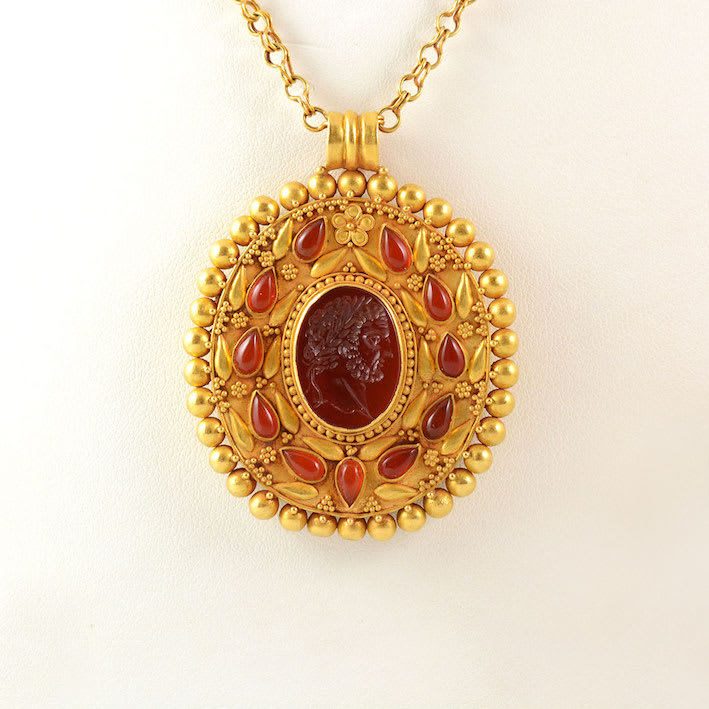Classical Revival Gold Necklace Featuring a Roman Carnelian Intaglio of Emperor Caracalla, 3rd Century CE - 19th Century CE
Gold and Carnelian
5.1 x 29.2 cm
2 x 11 1/2 in
2 x 11 1/2 in
FJ.7158
Further images
A genuine Ancient Roman carnelian intaglio seal depicting Emperor Caracalla (reigned 198-217 A.D.) has been set in a stunning gold pendant dating from the Classical Revival period. The art of...
A genuine Ancient Roman carnelian intaglio seal depicting Emperor Caracalla (reigned 198-217 A.D.) has been set in a stunning gold pendant dating from the Classical Revival period.
The art of glyptics, or carving on colored precious stones, is probably one of the oldest known to humanity. Intaglios, gems with an incised design, were made as early as the fourth and third millennia B.C. in Mesopotamia and the Aegean Islands. The exhibit a virtuosity of execution that suggests an old and stable tradition rooted in the earliest centuries. The tools required for carving gems were simple: a wheel with a belt-drive and a set of drills. Abrasives were necessary since the minerals used were too hard for a metal edge. A special difficulty of engraving intaglios, aside from their miniature size, was that the master had to work with a mirror-image in mind.
Caracalla was born April 4,188 in Lyon, where his father, Septimius Severus, was serving as governor of the province of Gallia Lugdunensis under Emperor Commodus. His name was changed from Lucius Septimius Bassianus to Marcus Aurelius Antoninus at the age of seven. From the time of his name change to Antoninus, Caracalla was the designated heir of Severus. Less than three years later he was proclaimed emperor, officially joining his father as co-rulers of the empire. Upon his father’s death in 211, Caracalla ruled the empire jointly with his brother, Geta, until he was murdered later the same year, leaving Caracalla in sole control at the age of 23. The year 212 saw a flurry of administrative reforms under the young emperor's leadership. Soldiers received increases in pay and in legal rights, but the most noteworthy change was the bestowal of Roman citizenship upon all free residents of the empire. In 217, Caracalla was assassinated on the road back from his military campaigns against the Parthians in the east. Although Caracalla remains a rather dubious figure, historians often overlook the energetic, reformist and even intellectual character of Caracalla's reign. The changes brought about in the little more than five years of Caracalla's sole rule would have long-lasting implications throughout the empire for generations to come.
The art of glyptics, or carving on colored precious stones, is probably one of the oldest known to humanity. Intaglios, gems with an incised design, were made as early as the fourth and third millennia B.C. in Mesopotamia and the Aegean Islands. The exhibit a virtuosity of execution that suggests an old and stable tradition rooted in the earliest centuries. The tools required for carving gems were simple: a wheel with a belt-drive and a set of drills. Abrasives were necessary since the minerals used were too hard for a metal edge. A special difficulty of engraving intaglios, aside from their miniature size, was that the master had to work with a mirror-image in mind.
Caracalla was born April 4,188 in Lyon, where his father, Septimius Severus, was serving as governor of the province of Gallia Lugdunensis under Emperor Commodus. His name was changed from Lucius Septimius Bassianus to Marcus Aurelius Antoninus at the age of seven. From the time of his name change to Antoninus, Caracalla was the designated heir of Severus. Less than three years later he was proclaimed emperor, officially joining his father as co-rulers of the empire. Upon his father’s death in 211, Caracalla ruled the empire jointly with his brother, Geta, until he was murdered later the same year, leaving Caracalla in sole control at the age of 23. The year 212 saw a flurry of administrative reforms under the young emperor's leadership. Soldiers received increases in pay and in legal rights, but the most noteworthy change was the bestowal of Roman citizenship upon all free residents of the empire. In 217, Caracalla was assassinated on the road back from his military campaigns against the Parthians in the east. Although Caracalla remains a rather dubious figure, historians often overlook the energetic, reformist and even intellectual character of Caracalla's reign. The changes brought about in the little more than five years of Caracalla's sole rule would have long-lasting implications throughout the empire for generations to come.
1
of
43





